Protection
Glass can be a dangerous material. When standard annealed glass breaks, it forms potentially lethal shards and splinters. The reputation for dangerous fragility is however fast disappearing.
Glass manufacturers have developed a range of safety glasses adding strength and integrity to this beautiful building material and allowing glass to be used in areas where safety is critical and in unprecedented situations.
Security is now also possible with glass. A range of high performance glasses allows light and vision into areas formerly excluded from natural light. Situations where customer interface and high security must coexist, need no longer seem threatening and unfriendly. There is a glass in the DUAL SEAL GLASS range to meet virtually any safety and security needs.
Safety glass
Safety glass is defined as glass which must have passed an impact test (currently EN12600:2002 pendulum impact test for glass in buildings) and either must not break or must break safely.
There are three levels of impact: 1, 2 and 3, 1 being the highest. Each involves the glass being impacted by a twin tyre design. (The test roughly simulates the impact of a child weighing 100lbs [45kg] hitting the glass with varying degrees of force.)
Three generic types of glass meet the requirement of this British Standard:
Laminated Glass (B)
Toughened Glass (C)
Wired Safety Glass(only to a limited extent see Wired glass)
All Security Glasses (see following section) automatically qualify as level 1 safety glasses.
Laminated glass
There are two types of laminated glass: PVB laminated and cast resin laminated glass. PVB laminated is the more commonly used variety.
Two or more sheets of glass are bonded together with one or more layers of polyvinyl butyral (PVB), a plastic interlayer in sheet form. The principal benefit of laminated glasses is their performance under impact.
For more information on the PVB laminated glass range from DUAL SEAL GLASS please contact technical sales office.
Resin laminated safety glass
Resin laminated glass is manufactured by pouring liquid resin into the cavity between two sheets of glass which are held together until the resin cures.

TOUGHENED GLASS
Toughened glass, also sometimes referred to as tempered glass, is four to five times stronger than ordinary annealed float glass and, if broken, disintegrates into small fragments with dulled edges that are unlikely to cause serious injury.
Prepared sheets of glass, which have been cut to size, processed and edgeworked as necessary, are heated to about 700°C in a furnace, which is just above the softening temperature of glass.
They are then chilled rapidly by cold air blown onto both surfaces.
This results in the two outer surfaces contracting and solidifying before the interior, which induces permanent compressive stresses into the surfaces of the glass, effectively increasing the strength of the glass. The interior of the glass naturally balances the compressive stress surface layers by being under tensile stress. It is these properties which result in the increased strength and safe breakage characteristics of thermally toughened glass.
When the central tensile section of the glass is ruptured, the stress is explosively released, producing the fracture characteristics of small, relatively harmless fragments sometimes referred to as dice.
In addition to being a Class A safety glass to BS 6206, the increased resistance of toughened glass to mechanical stress and to large temperature variations, render it ideally suited for use in structural glazing systems, where the glass is to be bolt or clamp fixed, and also in areas subject to high levels of thermal stress.
Note
A new British Standard for the manufacture of thermally toughened safety glass has now been adopted. The new standard is BS EN 12150 and will cover tolerances, flatness, edge-work, fragmentation and physical and mechanical characteristics of flat thermally toughened safety glass. Please contact us for more information.
Wired glass
A steel wire mesh is embedded within the glass and is intended to hold it in place if cracked. Under impact, the glass breaks in almost the same way as ordinary annealed glass into sharp dagger-like pieces.
Marking of safety glazing materials
ALL safety glazing materials are permanently marked in a position that will be visible after glazing with the following:
- The British Standard number EN12600.
- A code to identify the material e.g. B for laminated, C for toughened (tempered), P for plastic, W for wired, SFB for safety film backed.
- Its classification – 1, 2 and 3.
- Break pattern classification
- A name, trademark or identifiable mark of the manufacturer or the company who last cut the material if the original mark is lost in cutting. (The marking requirement applies to all panes, even in a multi-pane door and to both panes of a double-glazed unit.)
The use of safety glasses
The architectural use of safety glazing is primarily governed by British Standard BS 6262: Part 4: 1994 – Glazing for buildings – Safety related to human impact.
BS 6262 is a national standard applying to all glazing work, including replacement glazing and its essential requirements are detailed on the following pages.
BS 6262 identifies critical locations in general terms only and sets the minimum standards of glazing materials acceptable for use in these areas. It is the responsibility of the designer or the specifier to assess the risk in ANY area, taking account of the use of the building and the likely activity of the users.
Bathing areas, swimming pool, showers and other wet areas and gymnasia are all examples of areas of special risk.
Additional guidance is also provided by Building Regulations appropriate to the country – ie. Approved Document N for England and Wales, Part V for Northern Ireland and Part P of the Building Standards in Scotland.
Compliance with BS 6262 Part 4 will also satisfy the requirements of Regulation 14 of the Health and Safety at Work Act.
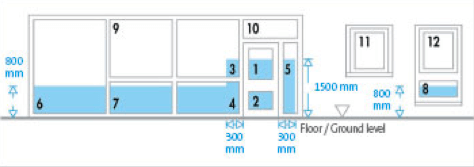
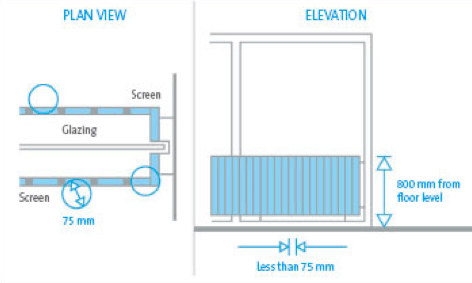
Glass in doors and side panels to glass in doors (1, 2, 3, 4, 5) must be at least:
- a Class B safety glazing material if the smaller dimension of the glass is more than 900mm
- a Class C safety glazing material if the smaller dimension of the glass is less than 900mm
- annealed (non-safety) glass in small panes may be permitted under certain controlled circumstances if it meets the criteria given below. See “Glazing in small panes.”
Glass in low level glazing (6, 7, 8) must be at least Class C, or in small panes. Annealed (non-safety) glass may be used in the unshaded areas (9, 10, 11, 12).
Robust annealed glass may be used in commercial frontages, details of which are given later in this section.
Permanent screen protection
The use of annealed (non-safety) glass is permitted in a critical location if protected by a permanent, robust screen. The screen must prevent the passage of a 75mm diameter sphere and must not be climbable. BS 6262: Part 4 details specific requirements for such screens and the full document should be consulted.
Glazing in small panes
Bathing areas and areas of special risk
BS 6262 requires that any glazing forming part of a bath or shower screen, or adjacent to or surrounding a bathing area, swimming pool or other wet areas must be at least a Class C material unless the standard requires the use of a higher class.
In these areas special consideration should be given to the height from floor level that safety glass is specified, as compliance to the minimum requirement of the standard may not afford adequate protection.
Consideration should also be given to the breakage characteristics. The fragmentation of toughened glass into small dice-like particles would result in, should it enter the pool, being invisible and practically impossible to remove, potentially causing damage to pumps and filters. This can be avoided by using a laminated safety glass such as SGG STADIP on account of the glass fragments remaining adhered to the plastic interlayer.
This requirement also applies to all glazing in areas of special risk such as gymnasia and other places of energetic activity. In such areas the designer must consider whether a higher Class is required, or if additional safeguards such as protective rails or screens, or manifestation, are necessary.
[It may also be concluded from the above that careful consideration must be given to all glazing and not just those specified as critical in Diagram 1.
Commercial frontages
Robust glass (non-safety thick annealed glass) when fully framed is considered suitable for use in large areas in non-domestic applications, for example forming fronts to shops, showrooms, offices, factories and public buildings.
[However, we strongly recommend the use of a safety glass.] Glass thickness/size limits for annealed glass that may be used in these locations are shown in Table 1. Wind loads and other loads must also be considered when selecting the glass thickness.
BS 6262: Part 4 does not permit the use of these glasses “in doors or side panels to doors”. (Areas 1, 2, 3, 4 and 5 of Diagram 1.)
Manifestation
Large areas of transparent glazing can be found both internally and externally in commercial buildings.
If the glass is not immediately obvious, due to the absence of substantial framing or fittings, BS 6262 part 4 states that it should be made apparent by some other form of manifestation.
The manifestation may take the form of decoration, solid or broken lines, patterns or company logos. It must be of a size to make it immediately noticeable and at an appropriate height between 600mm and 1500mm above floor level.
Special consideration should be given to areas of low level glazing in buildings which may cater for small children as their line of vision may be below normal heights for manifestation.
Manifestation should preferably be permanent, e.g. etching of the glazing. However, if applied materials are used they must be durable and not easily removed.

DESIGN LOADS
The loads used in the design of barriers incorporating glass largely depend on their location within a building and the building use, and should be determined
in accordance with BS 6399 part 1: Loading for buildings – Code of practice for dead and imposed loads 1996.
This specifies three design loads which barriers must be capable of withstanding:
- a uniformly distributed horizontal line load (kN/m) for the barrier, applied on a horizontal line 1100mm above finished floor level.
- a uniformly distributed load also known as UDL, (kN/m2), this load is applied over the entire surface of the glass panel.
- a point load (kN), this is a concentrated load applied to the glass panel generally over a square contact area of 50mm sides.
The loads are considered separately and are not cumulative. The design should take into account the most unfavourable likely imposed loads without excessive deflection or distortion. Deflection limits for barriers are given in BS 6180.
Where a building has several uses, either the worst case should be assumed or several barriers used as appropriate to each area.
If the barrier is external then the barrier must also be designed to withstand wind loads as outlined in BS 6399 part 2 Code of Practice for windloads.
There are basically three recognised types of barrier that can incorporate glass:
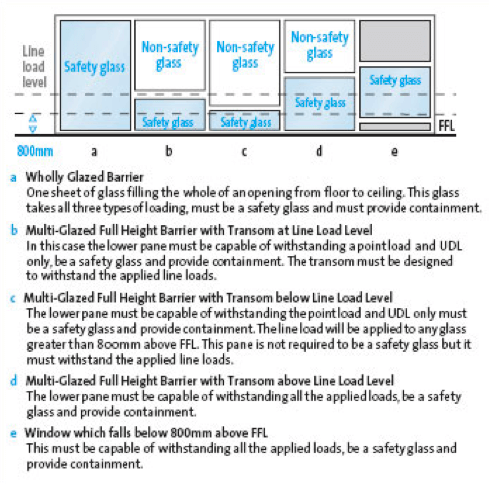
Full Height Barriers
Full height barriers can take many forms and are not necessarily composed of full floor to ceiling glass.
Where any part of a glazed structure, whether it forms the whole or part of a wall element, extends below the minimum barrier heights given in table 5 and is protecting a change in level as described earlier, it is classed as a full height barrier.
Examples of some of the various types of full height barrier are illustrated below:
Any glass forming part of a full height the infill panels. The glass is not barrier that extends partly or totally designed to provide any support to the below the minimum barrier height main frame. The glass in barriers with should withstand the appropriate infill infill panels should be designed to design loads relating to the building resist the design infill loads that are occupancy and also conform to the safety appropriate to building occupancy, glazing requirements of BS 6262 Part 4. and to provide containment.
Where the glass is coincident with the This means that under impact at minimum barrier height it should also appropriate design loads the glass be capable of sustaining the uniformly should not break or it should distributed horizontal line load.
Barriers With Glass Infills
These types of barrier are commonly referred to as glass balustrades and consist of a main frame of balusters and top rail with the glass used to form the infill panels. The glass is not designed to provide any support to the main frame. The glass in barriers with infill panels should be designed to resist the design infill loads that are appropriate to building occupancy, and to provide containment.
This means that under impact at appropriate design loads the glass should not break or it should prevent penetration.
The impact energy on the glass will vary according to the unhindered distance a body can travel in a direction perpendicular to the glass surface.
This is known as the “free path”. BS 6180 defines two impact classes for the basis of designing glass infill panels For a free path of up to 1500mm a minimum Class C, no penetration glass should be used. For a free path of greater than 1500mm a minimum Class A, no penetration glass should be used.
It should be noted that toughened glass meets the requirements of Class 1 of EN12600 due to its inherent safe breakage characteristics. It is now classified by EN12600 for resistance to penetration.
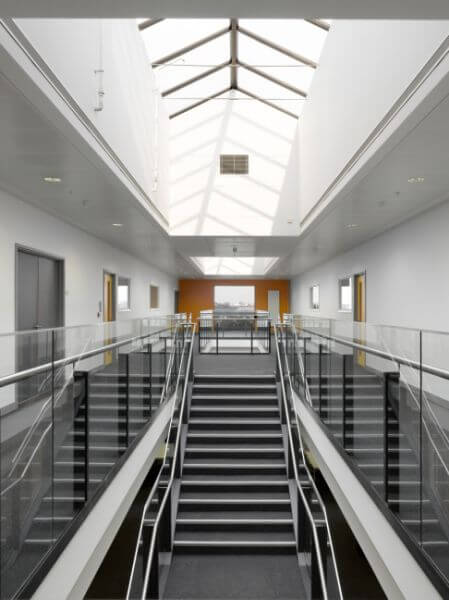
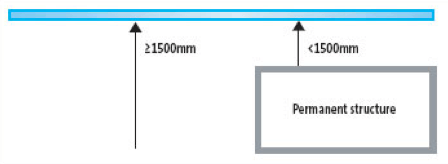
Therefore bs 6180 gives the following recommendations for impact classes:
- Class 2 to EN12600 – minimum 6mm toughened glass.
- Class 1 to EN12600 – minimum 10mm toughened glass.
The glass type used for the infill panels must be suitable for the method of fixing employed.
Toughened or toughened laminated glass can be used where the glass is either fully framed, two edge framed, bolt or clip fixed.
Laminated annealed glass is suitable for use in all barriers where the glass is fully framed.
Handrail attachment
Barriers that protect a change in level that is greater than 600mm should always incorporate a handrail.
A continuous handrail should be attached to the glass in such a manner that, should a glass panel fracture, the handrail will remain in position and will not fail if the uniformly distributed horizontal line load is applied across the resulting gap.
Continuous handrail fixing is recommended by BS 6180 because individual fixing points may introduce unacceptable stress concentrations.
Overhead glazing
For the purpose of the GLASS GUIDE, overhead glazing is defined as glazing that is inclined at an angle between horizontal and 75° from horizontal.
Overhead glazing has to withstand a greater range of loadings than vertical glazing and presents specific design and function issues.
Loadings
Like vertical glazing, the infill glass panels of any overhead glazing system must be designed to withstand the stress and deflection caused by wind loads.
This can be both positive pressure, and where the wind acts in suction, negative pressure. Unlike vertical glazing, consideration must also be given to loads caused by the formation of snow, ice and standing water and for the self-weight of the glass itself. The dead load of the self-weight of the glass is a permanent gravity load and imposed loads due to snow, ice and standing water could also potentially be loads for an extended length of time. Glass is significantly weaker to sustained loads such as self-weight and snow loads than it is for uniform loads of short duration. It is therefore essential that consideration be given to the duration of the various loads to be taken into account when specifying glass for use in overhead glazing. The building designer should also consider the safe means of access to overhead glazing for maintenance purposes. Loads incidental to maintenance should never be carried directly by the infilling.
Guidance is provided by BS 5516 1991 Design and installation of sloping and vertical patent glazing.
Loadings for overhead glazing are obtained from BS 6399 part 2 Code of practice for wind loads and BS 6399 part 3 Code of practice for imposed roof loads.
Performance
Due to the inclined angle of overhead glazing, the solar intensity can, for certain orientations, be greater than that of vertical glazing. This increases the levels of thermal stress induced in the glass, particularly where energy-absorbent solar control glasses are specified. Similarly the level of heat loss through inclined glazing can also be higher.
The U-values quoted in the data sheets are in accordance with BS EN 673 for vertical glazing and corrections are necessary for inclined glazing.
Please contact dualseal for detailed information.
Safety
Overhead glazing is more susceptible to impact from falling objects and wind-borne debris than vertical glazing.
Glass is also more likely to fall out of the frame when broken, therefore careful consideration must be given to the breakage characteristics of the specified glass.
In recognition of the breakage characteristics of toughened glass, we strongly recommend the use of a laminated glass in single-glazed or as the inner pane of a double-glazed unit where it is necessary to minimise the risk of glass falling after breakage.
In certain circumstances however, it may be considered acceptable for heat soak tested toughened glass to be used. The heat soak test must be specified to reduce the very rare risk of spontaneous breakage due to nickel sulphide inclusions.
Please contact dualseal for detailed information.
Drainage
Consideration should be given to the effective drainage of rainwater and condensation from the glazing. If water is allowed to collect on surfaces close to the horizontal, problems with sediment build-up and long term etching may become apparent.
